Buy only electrical appliances which meet the local statutory safety requirements (see note 1) for use in Hong Kong. Electrical appliances which are brought outside Hong Kong may not be suitable for use under the local power supply conditions (e.g. rated voltage and frequency) and environmental conditions (e.g. temperature and humidity).
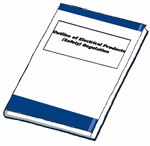
Electrical appliances must bear the proper markings as shown on the diagram or be accompanied with a notice indicating the same.
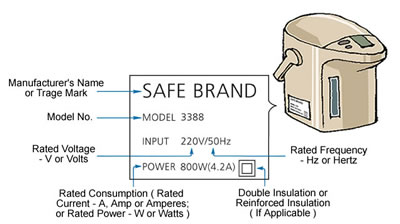
Apart from fixed electrical appliances (e.g. ceiling luminaires and electric water heaters) which do not receive power supply from socket outlets, an electrical appliance must be fitted with a 3-pin plug which complies with the safety requirements.
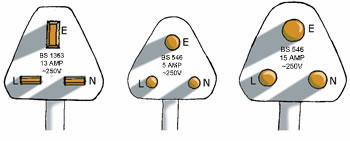
Do not buy or use any electrical appliance which is fitted with a 2-pin plug unless the appliance is fitted with a 2-round-pin plug which complies with safety standard BS4573 or EN50075 and is designed to receive power supply from a shaver supply unit inside a bath room (e.g. electric shaver, toothbrush or epilator).
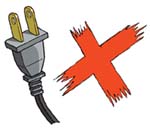
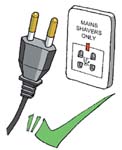
For all fixed electrical appliances which do not receive power supply from socket outlets, the connection of power supply must be carried out by a registered electrical contractor (see Part 3 for details).
To prevent electric shock, electrical appliances must be effectively earthed, i.e. the metallic casing of an electrical appliance is connected to the "earth" pin of its plug. Electrical appliances without earth connection must be of double insulation or reinforced insulation design, and such appliances usually bear a symbol "  ".
".
Electrical appliances must be accompanied by proper operation manuals depicting the installation, assembly and operation procedures and safety precautions. Adhere to the instructions given in its manual when using an electrical appliance.
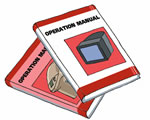
Any electrical appliance of rated voltage less than 200V a.c. (e.g. audio-video (AV) appliances rated at 110V a.c.) must not be connected directly to the 220V a.c. household power supply system in Hong Kong. Any such appliance must bear a proper warning label.
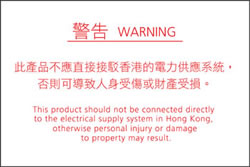
Set the voltage selector, if any, on an electrical appliance to 220V a.c. (the household voltage in Hong Kong). Otherwise, it may damage the appliance and cause fire.
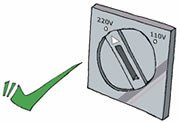
Before use, check electrical appliances (including plugs and flexible power cords) to see if they are damaged or worn-out, especially when they have not been used for a prolonged period of time.
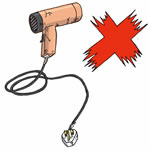
Electrical appliances must be fitted properly and with robust structures for stable operation. Under normal operation, there should not be any sign of overheating (e.g. discolouration, charring and deformation) or difficult starting, excessive noise or vibration, crack or loosen part. If the safety of an electrical appliance is in doubt, stop using it and hand it to an experienced technician for inspection.
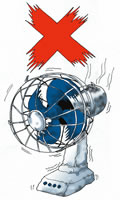
Switch on an electrical appliance only after firmly plugging it into a socket outlet, and unplug an electrical appliance only after switching it off. Otherwise, it may cause hazard arising from sparking.
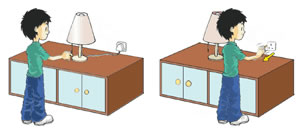
Do not unplug an electrical appliance by pulling its flexible power cord. Otherwise, it may damage the wire connection and cause danger.
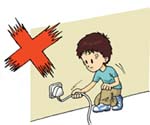
Ensure that there is sufficient space around an electrical appliance for heat dissipation. To prevent overheating and fire, do not cover electrical appliances or place objects around them. TV sets and other AV products, chargers, luminaires, electric fans, electric heaters, refrigerators and washers/dryers, etc. are of particular concerns.
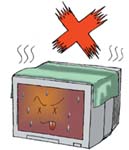
An electrical appliance with high power consumption (e.g. air-conditioner, dehumidifier, electric heater, electric water kettle/pot, electric rice cooker and washer/dryer) should receive power supply from a single fixed socket outlet to which the connection of any other appliance should be avoided.
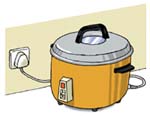
Keep children away from operating electrical appliances, especially those with heating or rotating parts (e.g. luminaires, hair dryers, irons, electric heaters, electric cooking ovens, electric fans and washers/dryers).
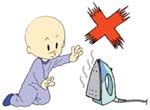
Do not let the flexible power cord of any electrical appliance touch or be too close to any hot object (e.g. cooking range and electric heater).
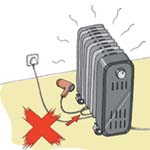
To prevent danger, do not let water seep into or place any vessel containing water on any electrical appliance. Keep electrical appliances away from windows or balconies.
.jpg)
.jpg)
.jpg)
To prevent electric shock, avoid using any extension unit in a wet or humid environment (e.g. bathroom or kitchen). Great care should be taken whilst using an electrical appliance in such environment.
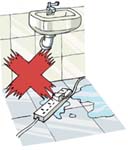
Avoid touching any electrical appliance, socket outlet or switch if hands are wet.
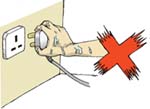
Place an electrical appliance on a flat and firm surface, and ensure that no excessive tension is applied to its flexible power cord.
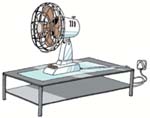
Do not use any inflammable chemical substance (e.g. insecticide and thinner) near an operating electrical appliance.
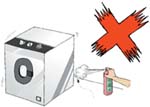
For safety, before going out, electrical appliances (other than essential appliances) should be switched off as far as practicable.
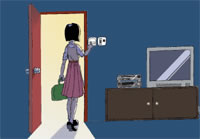
For some electrical appliances, the starting current may be several times greater than that at normal operation. Therefore, when a blackout occurs, major electrical appliances should be switched off to avoid, when power supply is resumed, the occurrence of momentary circuit overload and hence a blackout again. Besides, it may cause injury if an electrical appliance with heating or rotating part operates without the user's prior awareness.